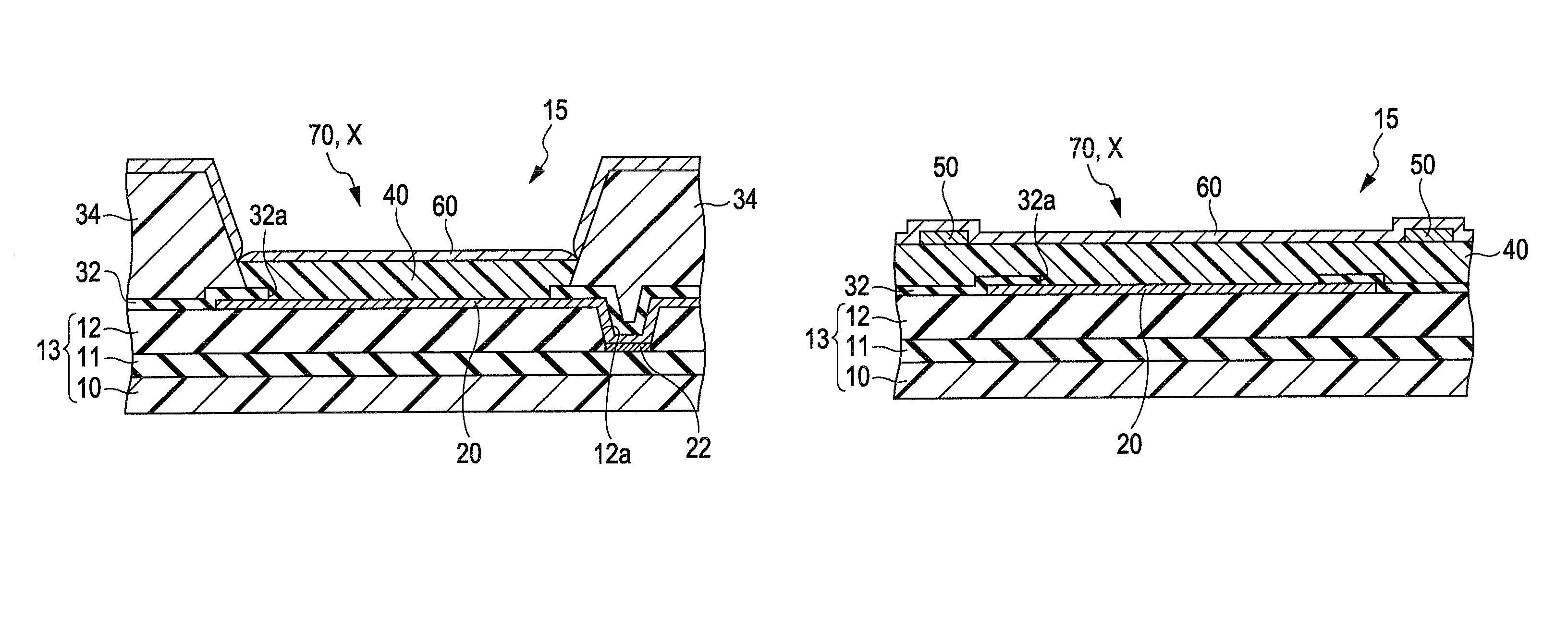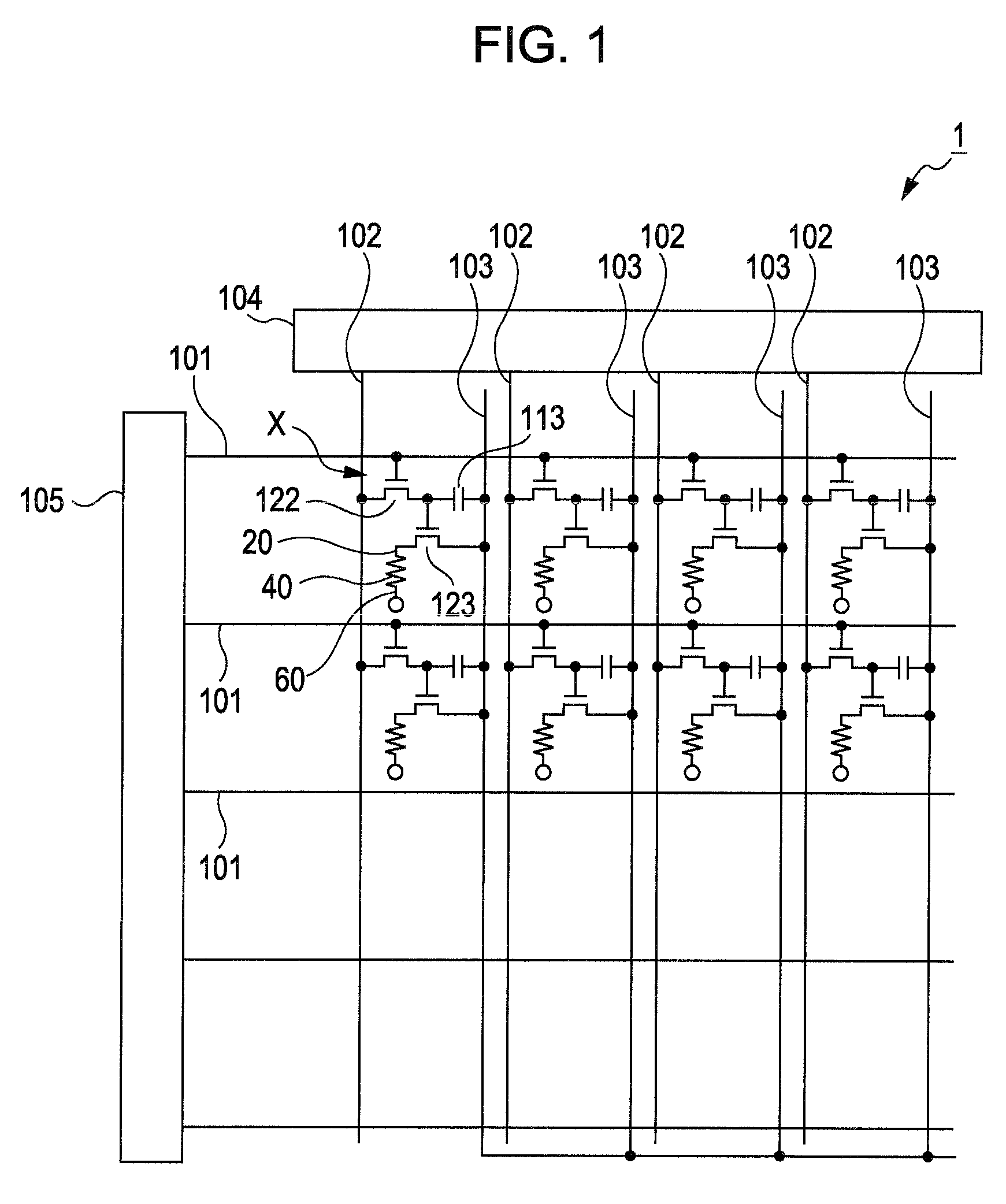Organic electroluminescence device capable of preventing light from being not emitted
a technology of electroluminescence device and organic material, which is applied in the direction of discharge tube/lamp details, discharge tube luminescnet screen, other domestic articles, etc., can solve the problems of deteriorating display quality, and achieve the effect of low resistance of the second electrod
- Summary
- Abstract
- Description
- Claims
- Application Information
AI Technical Summary
Benefits of technology
Problems solved by technology
Method used
Image
Examples
first embodiment
[0055]Next, a specific configuration example of the organic EL device will be described with reference to a first embodiment of the invention. FIG. 3 is an enlarged top view illustrating major constituent elements of the organic EL device according to the first embodiment of the invention. FIG. 4A is a sectional view taken along the line IVA-IVA of FIG. 3. FIG. 4B is a sectional view taken along the line IVB-IVB of FIG. 3. FIG. 4C is a sectional view taken along the line IVC-IVC of FIG. 3.
[0056]In the organic EL device 1 according to this embodiment, as shown in FIG. 3, numerous partition walls 34 are arranged in a stripe shape. Each of concave portions 15 is formed between the adjacent partition walls 34. Numerous auxiliary cathode wires (auxiliary electrodes) 50 perpendicular (intersected) to the partition walls 34 are arranged in a stripe shape. Here, the stripe shape includes a shape in which the numerous partition walls 34 are connected to each other in ends or numerous auxilia...
second embodiment
[0086]Next, an organic EL device will be described according to a second embodiment of the invention, FIG. 5 is an enlarged top illustrating major constituent elements of the organic EL device according to the second embodiment of the invention. FIG. 6A is a sectional view taken along the line VIA-VIA of FIG. 5. FIG. 6B is a sectional view taken along the line VIB-VIB of FIG. 5. FIG. 6C is a sectional view taken along the line VIC-VIC of FIG. 5.
[0087]A difference between the organic EL device according to this embodiment shown in FIG. 5 and the organic EL device according to the first embodiment in FIG. 3 is the configurations of the partition wall, the concave portion formed by the partition wall, and the auxiliary cathode wire.
[0088]That is, in the organic EL device according to this embodiment, as shown in FIG. 5, the partition walls 34 are constituted by first partition walls 34a and second partition walls 34b. In addition, the concave portions 15 formed on the sides of the firs...
third embodiment
[0101]Next, an organic EL device will be described according to a third embodiment of the invention. FIG. 7 is an enlarged top illustrating major constituent elements of the organic EL device according to the third embodiment of the invention. FIG. 8A is a sectional view taken along the line VIIIA-VIIIA of FIG. 7. FIG. 8B is a sectional view taken along the line VIIIB-VIIIB of FIG. 7. FIG. 8A is a sectional view taken along the line VIIIC-VIIIC of FIG. 7.
[0102]A difference between the organic EL device according to this embodiment shown in FIG. 7 and the organic EL device according to the first embodiment in FIG. 3 is the configurations of the partition wall, the concave portion formed by the partition wall, and the auxiliary cathode wire.
[0103]That is, in the organic EL device according to this embodiment, as shown in FIG. 7r the partition walls 34 are not arranged in the stripe shape, but arranged horizontally and vertically in a lattice shape. Each of portions surrounded by the p...
PUM
 Login to View More
Login to View More Abstract
Description
Claims
Application Information
 Login to View More
Login to View More - R&D
- Intellectual Property
- Life Sciences
- Materials
- Tech Scout
- Unparalleled Data Quality
- Higher Quality Content
- 60% Fewer Hallucinations
Browse by: Latest US Patents, China's latest patents, Technical Efficacy Thesaurus, Application Domain, Technology Topic, Popular Technical Reports.
© 2025 PatSnap. All rights reserved.Legal|Privacy policy|Modern Slavery Act Transparency Statement|Sitemap|About US| Contact US: help@patsnap.com



